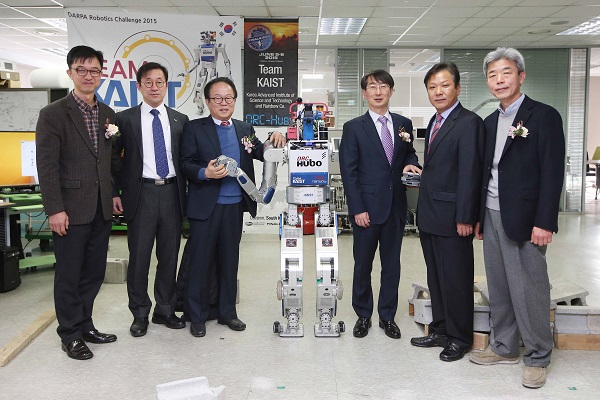policy

(Photo from left: Kyong-Hoon Kim from Korea Evaluation Institute of Industrial Technology, Vice President of Research at KAIST Hee-Yoon Lee, Director Oh, Jong-Hwan Kim at the Ministry of Trade, Industry and Energy, President Ki-Han Park at the Korea Institute for Robot Industry Advancement, and Dean of KAIST Institute Yun Chol Chung.)
KAIST opened its Humanoid Robot Research Center on January 19 at the KAIST Institute. Endorsed by the Ministry of Trade, Industry and Energy with 15 billion KRW funding over five years, the center will conduct research for advancing humanoid robot technology and fostering research fellows in the field.
Professor Jun Ho Oh at the Department of Mechanical Engineering will serve as the director of the center. Team KAIST under Professor Oh won the 2015 DARPA Robotics Challenge (DRC) with its humanoid robot DRC-HUBO, beating 23 teams from six countries.
Professor Oh said, “I believe we have already achieved technological prowess through developing the HUBO robot over the past decade. The center will continue to strive for further development of original technology crucial for humanoid robots’ key components. We want to pave the way for having enough of our own technology and needing to bring in technology from abroad. Professor Oh said he will focus on fields such as high-efficiency, high-powered electric drives and hydraulic system humanoid robot capable of executing solid manipulability with high confidence and object recognition intelligence technology. In addition, he said the center will develop module type and extended open software in an effort to disseminate robot technology.
-
research KAIST researcher Se Jin Park develops 'SpeechSSM,' opening up possibilities for a 24-hour AI voice assistant.
<(From Left)Prof. Yong Man Ro and Ph.D. candidate Sejin Park> Se Jin Park, a researcher from Professor Yong Man Ro’s team at KAIST, has announced 'SpeechSSM', a spoken language model capable of generating long-duration speech that sounds natural and remains consistent. An efficient processing technique based on linear sequence modeling overcomes the limitations of existing spoken language models, enabling high-quality speech generation without time constraints. It is expe
2025-07-04 -
event King Saud University and KAIST discussed Strategic AI Partnership
<From left> President Abdulla Al-Salman(King Saud University), President Kwang Hyung Lee(KAIST) KAIST (President Kwang Hyung Lee) and King Saud University (President Abdulla Al-Salman) held a meeting on July 3 at the KAIST Campus in Seoul and agreed to pursue strategic cooperation in AI and digital platform development. The global AI landscape is increasingly polarized between closed models developed by the U.S. and China’s nationally focused technology ecosystems. In this context
2025-07-04 -
research KAIST Uses AI to Discover Optimal New Material for Removing Radioactive Iodine Contamination
<(From the Right) Professor Ho Jin Ryu, Department of Nuclear and Quantum Engineering, Dr. Sujeong Lee, a graduate of the KAIST Department of Materials Science and Engineering, and Dr. Juhwan Noh of KRICT’s Digital Chemistry Research Center> Managing radioactive waste is one of the core challenges in the use of nuclear energy. In particular, radioactive iodine poses serious environmental and health risks due to its long half-life (15.7 million years in the case of I-129), hi
2025-07-03 -
research KAIST Enhances Immunotherapy for Difficult-to-Treat Brain Tumors with Gut Microbiota
< Photo 1.(From left) Prof. Heung Kyu Lee, Department of Biological Sciences, and Dr. Hyeon Cheol Kim> Advanced treatments, known as immunotherapies that activate T cells—our body's immune cells—to eliminate cancer cells, have shown limited efficacy as standalone therapies for glioblastoma, the most lethal form of brain tumor. This is due to their minimal response to glioblastoma and high resistance to treatment. Now, a KAIST research team has now demonstrated a new th
2025-07-02 -
event 2025 KAIST Global Entrepreneurship Summer School Concludes Successfully in Silicon Valley
< A group photo taken at the 2025 GESS Special Lecture.Vice President So Young Kim from the International Office, VC Jay Eum from GFT Ventures, Professor Byungchae Jin from the Impact MBA Program at the Business School, and Research Assistant Professor Sooa Lee from the Office of Global Initiative> The “2025 KAIST Global Entrepreneurship Summer School (2025 KAIST GESS),” organized by the Office of Global Initiative of the KAIST International Office (Vice President
2025-07-01